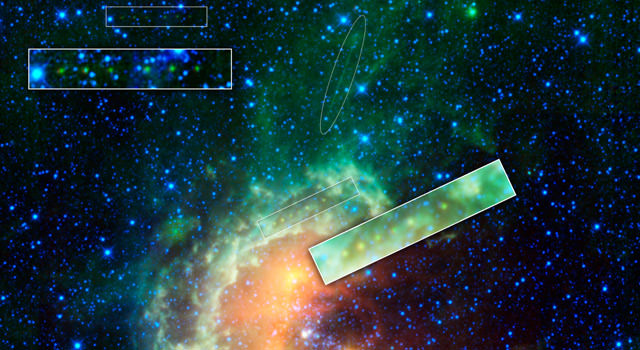[/caption]
The Tadpole nebula is looking very stylish in this new infrared image from the WISE spacecraft, NASA’s Wide-field Infrared Survey Explorer. An asteroid appears like a string of pearls — seen as a line of yellow-green dots in the boxes near center — in this stitched together mosaic. The Tadpole is a star-forming region in the Auriga constellation about 12,000 light-years from Earth. As WISE scanned the sky, it happened to catch asteroid 1719 Jens in action, moving across WISE’s field of view. A second asteroid was also observed cruising by, as highlighted in the boxes near the upper left (the larger boxes are blown-up versions of the smaller ones).
More on this image below, but the WISE team received a bit of bad news this week.
WISE principal investigator Ned Wright and his team had proposed a three-month “warm” extension of the mission after the supply of hydrogen that cools the telescope and detectors on board runs out. However, according to an article in Space News, NASA’s 2010 Astrophysics Senior Review Committee recommended that the mission not be extended, and end as originally planned in October of this year.
While WISE is expected to produce significant results, the committee said there was not adequate scientific justification to continue the mission.
The proposed additional three months, known as Warm WISE – where the spacecraft would observe in two of the four infrared wavelengths it has available when WISE is cooled –would have added $6.5 million to the program’s $320 million price tag.
Currently, WISE produces approximately 7,500 images a day.
And this latest image is a “gem.”
It consists of twenty-five frames, taken at all four of the wavelengths and were combined into one image: infrared light of 3.4 microns is color-coded blue: 4.6-micron light is cyan; 12-micron-light is green; and 22-micron light is red.
But wait, there’s more! Also visible in the image are two satellites orbiting above WISE (highlighted in the ovals). They streak through the image, appearing as faint green trails. The apparent motion of asteroids is slower than satellites because asteroids are much more distant, and thus appear as dots that move from one WISE frame to the next, rather than streaks in a single frame.
This Tadpole region is chock full of stars as young as only a million years old — infants in stellar terms — and masses over 10 times that of our sun. It is called the Tadpole nebula because the masses of hot, young stars are blasting out ultraviolet radiation that has etched the gas into two tadpole-shaped pillars, called Sim 129 and Sim 130. These “tadpoles” appear as the yellow squiggles near the center of the frame. The knotted regions at their heads are likely to contain new young stars. WISE’s infrared vision is helping to ferret out hidden stars such as these.
WISE is an all-sky survey, snapping pictures of the whole sky, including everything from asteroids to stars to powerful, distant galaxies.
Sources: JPL, Space News

